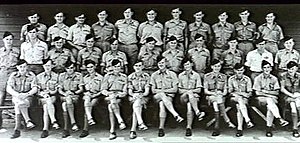No. 6 Service Flying Training School RAAF
| No. 6 Service Flying Training School RAAF | |
|---|---|
 Trainees of No. 6 Service Flying Training School, c. 1944 | |
| Active | 1941–1946 |
| Allegiance | Australia |
| Branch | Royal Australian Air Force |
| Role | Intermediate/advanced flying training |
| Part of | No. 1 Training Group |
| Garrison/HQ | RAAF Station Mallala |
No. 6 Service Flying Training School (No. 6 SFTS) was a flying training school of the Royal Australian Air Force (RAAF) during World War II. It was formed in August 1941, and commenced flying the following month. Responsible for intermediate and advanced instruction of pilots under the Empire Air Training Scheme (EATS), the school was based at RAAF Station Mallala, South Australia, and operated Avro Anson and Airspeed Oxford aircraft. The school formed a reserve squadron for Australia's defence after the outbreak of war in the Pacific in December 1941. Having graduated over 2,000 pilots, No. 6 SFTS completed its final training course in September 1945, and was re-formed as Care and Maintenance Unit Mallala in January 1946.
History
RAAF aircrew training expanded dramatically following the outbreak of World War II, in response to Australia's participation in the Empire Air Training Scheme (EATS). The Air Force's pre-war flight training facility, No. 1 Flying Training School at RAAF Station Point Cook, Victoria, was supplanted in 1940–41 by twelve Elementary Flying Training Schools (EFTS), eight Service Flying Training Schools (SFTS), and Central Flying School (CFS).[1][2] While CFS turned out new flight instructors, the EFTS provided basic training to prospective pilots who, if successful, would go on to an SFTS for further instruction that focussed on operational (or "service") flying.[1][3] The course at SFTS typically consisted of two streams, intermediate and advanced, and included such techniques as instrument flying, night flying, advanced aerobatics, formation flying, dive bombing, and aerial gunnery.[1][4] The total duration of training varied during the war as demand for aircrew rose and fell. Initially running for sixteen weeks, the course was cut to ten weeks (which included seventy-five hours flying time) in October 1940. A year later it was raised to twelve weeks (including 100 hours flying time), and again to sixteen weeks two months later. It continued to increase after this, peaking at twenty-eight weeks in June 1944.[4]
No. 6 Service Flying Training School (No. 6 SFTS) was formed at

Thirty-nine fatalities were recorded during training flights, involving fourteen Ansons and two Oxfords.
Following the outbreak of the
Notes
- ^ a b c Stephens, The Royal Australian Air Force, pp. 67–70
- ^ Gillison, Royal Australian Air Force 1939–1942, p. 111
- ^ Gillison, Royal Australian Air Force 1939–1942, p. 97
- ^ a b Gillison, Royal Australian Air Force 1939–1942, p. 109
- ^ a b c d e f RAAF Historical Section, Units of the Royal Australian Air Force, pp. 109–110
- ^ a b "Air Training Schools In S.A." The Advertiser. Adelaide: National Library of Australia. 16 September 1941. p. 6. Retrieved 30 May 2012.
- ^ "R.A.A.F. Training School At Mallala Open Soon". The Advertiser. Adelaide: National Library of Australia. 12 September 1941. p. 4. Retrieved 30 May 2012.
- ^ a b c Ingman, Peter (December 2019). "No. 6 Service Flying Training School, Mallala" (PDF). South Australian Aviation Museum. pp. 11–14. Archived from the original (PDF) on 16 March 2022. Retrieved 28 September 2022.
- ^ Avro Anson Accidents Part 14, p. 15 at National Archives of Australia. Retrieved on 30 May 2012.
- ^ Gillison, Royal Australian Air Force 1939–1942, pp. 234–238
- ^ RAAF Historical Section, Units of the Royal Australian Air Force, p. 104
- ^ Stephens, Going Solo, pp. 12–13
- ^ "Mallala-Based Planes For Rocket Project". The Advertiser. Adelaide: National Library of Australia. 30 June 1947. p. 3. Retrieved 30 May 2012.
- ^ Stephens, Going Solo, pp. 446–447
References
- Gillison, Douglas (1962). Australia in the War of 1939–1945: Series Three (Air) Volume I – Royal Australian Air Force 1939–1942. Canberra: OCLC 2000369.
- RAAF Historical Section (1995). Units of the Royal Australian Air Force: A Concise History. Volume 8: Training Units. Canberra: Australian Government Publishing Service. ISBN 0-644-42800-7.
- Stephens, Alan (1995). Going Solo: The Royal Australian Air Force 1946–1971. Canberra: Australian Government Publishing Service. ISBN 0-644-42803-1.
- Stephens, Alan (2006) [2001]. The Royal Australian Air Force: A History. London: ISBN 0-19-555541-4.
